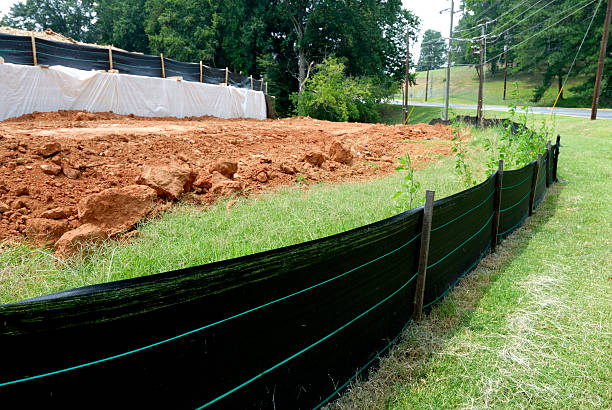Expert Providers by Memphis Erosion Control Solutions excavation
Wiki Article
Best Practices for Erosion Control in Building Projects
Are you dealing with a building and construction project and concerned regarding disintegration control? Look no more! In this post, we will certainly lead you via the very best techniques for protecting against erosion on your site. You'll discover 5 necessary techniques, efficient sediment and runoff monitoring methods, vital considerations for slope stablizing, and ideas for shielding vegetation and soil. We'll also dig into the importance of applying proper drain systems. Prepare yourself to deal with erosion head-on and guarantee the success of your building project.5 Crucial Erosion Control Methods

To properly regulate erosion on your building site, you'll need to implement vital strategies such as slope stabilization and sediment control steps. Incline stabilization is vital in protecting against soil disintegration on high inclines. One more efficient method is the use of erosion control blankets or floor coverings, which are put on the incline and assistance preserve soil fragments while enabling plant life to expand.
Efficient Debris and Overflow Monitoring

You can properly take care of debris and drainage in your building and construction project by applying correct erosion control steps. An additional essential technique is the implementation of disintegration control blankets or mats. By executing these disintegration control procedures, you can effectively take care of sediment and drainage in your building project, decreasing the impact on the environment and abiding with regulative demands.
Secret Considerations for Slope Stabilization
You need to very carefully analyze the slope's characteristics, such as its angle, drain, and make-up patterns. Look for signs of disintegration, such as subjected roots, cracks, or down soil.One more alternative is to plant plants on the incline, as the origins can help anchor the dirt and control disintegration. In addition, mounting erosion control coverings or floor coverings can provide immediate defense while plant life ends up being established.
It's important to frequently monitor the stabilized inclines to ensure their performance. Keep an eye out for any signs of movement or disintegration, and take immediate activity if essential. Regular maintenance, such as examining and fixing any broken steps, is additionally necessary to ensure long-lasting stability.
Ideal Practices for Vegetation and Soil Security
If required,One effective means to secure vegetation and soil on inclines is by frequently inspecting for indicators of erosion and taking prompt activity. By being aggressive and observant, you can stop further damage and make certain the stability of the slope. Beginning by evaluating the slope for any signs of erosion, such as subjected origins, bare dirt spots, or debris build-up near the bottom. It is important to address the problem without delay if you see any of these signs. Implement disintegration control steps such as setting up erosion control blankets, mulching, or also constructing maintaining wall surfaces if required. In addition, planting greenery can dramatically aid in stabilizing the soil. Select indigenous plants that have deep root systems, as they great post to read are much more effective in preventing erosion. Ensure to regularly assess the wellness of the plants and offer essential upkeep, like watering and feeding. Keep in mind, erosion can quickly intensify and cause extreme damages, so it's vital to address it as soon as possible. By taking aggressive procedures and consistently monitoring the incline, you can safeguard the greenery and dirt, making certain the long-lasting stability of the location.Implementing Appropriate Drainage Equipments
When it comes to managing water flow and preventing erosion, understanding these elements is crucial. Steeper slopes can lead to much faster water flow, enhancing the risk of disintegration and flooding. On the other hand, gentler slopes allow water to stream more gradually, minimizing erosion capacity.Sandy dirts have a tendency to drain why not find out more faster due to their crude structure, while clay dirts have a slower water drainage rate due to their compact nature. Additionally, considering the dirt features aids protect against waterlogging, which can lead to inadequate plant growth and damage to frameworks.
Final Thought
In conclusion, when it comes to disintegration control in construction projects, you must adhere to these best techniques. Execute efficient debris and drainage management techniques to avoid pollution. Take into consideration slope stablizing methods to make certain the stability of the site. Shield greenery and dirt by using proper measures. Finally, establish appropriate water drainage systems to manage water circulation. By complying with these crucial practices, you can efficiently manage disintegration and make certain the success of your building task.To successfully manage erosion on your building site, you'll need to apply essential strategies such as incline stablizing and debris control procedures. Slope stabilization is essential in avoiding soil erosion on high inclines. One more reliable strategy is the use of disintegration control blankets or mats, which are positioned on the incline and aid retain dirt bits while enabling vegetation to expand. One more option is to grow greenery on the slope, as the origins can assist anchor the dirt and control erosion. Implement erosion control actions such as setting up landscape firm erosion control coverings, mulching, or even constructing retaining wall surfaces if needed.
Report this wiki page